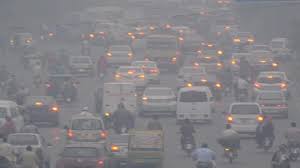Massive Fines Imposed on Smoke-Emitting Vehicles to Combat Smog

To fight the increasing smog problem in the province of Punjab, local authorities have levied heavy fines on all smoke-emitting vehicles across the province. In just 24 hours, the Punjab Traffic Police charged over 8,500 vehicles with a cumulative amount of fines worth Rs 171.18 million. This crackdown has begun against cars, trucks, and motorbikes that contribute to the hazardous air quality in the region. It goes in line with the directives given by the Lahore High Court and shows the severity of the pollution problem major cities are facing including Lahore, Multan, Gujranwala, and Faisalabad.
Rising Smog Levels: A Health and Environmental Hazard With Lahore topping the Air Quality Index (AQI) rankings as one of the most polluted cities in the world, this smog has brought serious health issues for residents. And many of you will be thinking about the major factors behind the smog. Well, vehicle emissions are among the primary reasons, at least that is what the Punjab Environment Protection Department thinks. These emissions comprise injurious pollutants like sulfur dioxide, nitrogen oxides, and particulate matter leading to respiratory problems, eye irritation, and poor visibility.
The air quality index in Lahore has varied over time and often touch “hazardous” levels of pollution. Many times the reading has surpassed the 300 mark on the AQI scale, making it lethal for the vulnerable section such as children, the elderly, and those with prior health disorders.
Fines: A Province-Wide Operation In Lahore alone, the Traffic Police fined 3,153 vehicles in a single day, collecting Rs. 6.3 million in fines. Officials report that 1,663 motorcycles were penalized for emitting excessive smoke, while an additional 536 were impounded. Heavy fines were also levied against over 3,700 tractor-trolleys transporting soil and sand without adequate covering, with unshielded vehicles contributing significantly to airborne dust and particulate matter.
Additionally, artificial intelligence (AI) systems have been deployed already to identify and track polluting vehicles and over 300 vehicles were e-challaned through this AI tracking system. Numerous checkpoints have been established at key entry points of the major cities. Anti-smog squads have been deployed across the region in order to ensure continuous, consistent enforcement and monitor compliance with new regulations.
Beyond Fines: Broader Smog Control Measures The third measure by the Punjab government is to strictly disallow all heavy and smoke-generating vehicles in Lahore. In this regard, the police are checking up all incoming vehicles at 12 key checkpoints and only allowing essential transport only like fuel, medicines, and food carriers after complete checks. In a joint effort with the Environmental and Mines Departments, the Lahore Traffic Police had already been making an effort in this regard to curb the influx of pollution into the city.
The Road Ahead: Can These Measures Make a Difference? While fines and the banning of vehicles can be quite promising first steps, however, it is a long way to clear the air in Punjab. Smog has been haunting cities in Punjab for years, mainly on account of traffic emissions, industrial pollution, and seasonal agricultural practices. However, it isn’t the only step the government is considering. Artificial rain through cloud seeding is also on the government’s list of solutions to tackle pollution. But this method is cost-intensive.
A Call for Public Awareness and Action Public health warnings have been issued, asking the citizens to remain indoors when possible, and wear masks outdoors. Many schools, parks, and public places have temporarily been shut down for limited exposure. Shopping malls and commercial plazas have been asked to install air purifiers in order to maintain even cleaner indoor air conditions. If you want to choose from the best air purifiers in Pakistan, our blog can help you.
Effective countermeasures against smog must be multi-faceted. While immediate measures such as fines, bans, and technological measures are necessary, there is an equal importance attached to fighting pollution at its long-term sources. Transitioning to cleaner fuel sources and upgrading the public transport system can also be beneficial.
In the end, the solution to environmental pollution does not lie with the government only but with everyone: Everyone must play a role in this battle against smog. One step can be reporting smoke-emitting vehicles on emergency number 15.